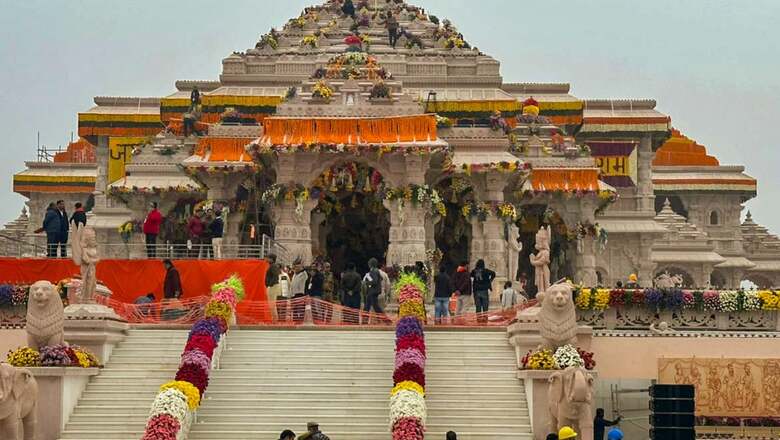
views
We are living in a time when the very idea of ‘Bharat’ as a modern nation-state has come under intense scrutiny. Newspaper columns are brimming with arguments and counter-arguments, each vying to establish a ‘specific’ narrative. With the ‘Pran Pratishtha’ (consecration) of Ram Mandir in Ayodhya, this debate has reached its crescendo. A section of intelligentsia, both in India and abroad, outraged by the prospect of Hindu resurgence, has gone to extremes to proclaim the demise of secular ideals in the country’s polity.
There is no gainsaying the fact that India, under Prime Minister Narendra Modi, has seen a marked departure from the Nehruvian idea of secularism, demonstrating a palpable desire to embrace its ancient roots which Nehru once disparagingly referred to as the “deadwood of the past.” The question emerges: does the fall of ‘Nehru’s secular temple’ inherently signify the fall of India as a pluralist society? The question necessitates a detailed and nuanced response.
Nehru, who called himself “the last Englishman to rule India,” viewed the country through a Westernised lens and consistently failed to appreciate India’s civilisational strength. The type of secularism he attempted to impose on India ran counter to the dharmic character of the land. After all, India is known to be the land where ‘dharma’ forms an integral part of the individual and collective existence of its people; even our identity as a modern nation-state has intricately been shaped by ideals enshrined in our dharmic texts.
Terms like Satyameva Jayate (the national motto), Dharmo Rakshati Rakshitah (ideal of the Research and Analysis Wing), Yato Dharmastato Jayah (Supreme Court’s baseline), Bahujan Hitaya, Bahujan Sukhaya (All India Radio), Satyam Shivam Sundaram (Doordarshan), Seva Asmakam Dharmah (Indian Army), Nabhah Sparsham Deeptam (Indian Air Force), Kosh Mulo Dand (Income Tax) and Yogakshemam Vahamyaham (LIC) have all been borrowed from our ancient scriptures.
The original copy of the Constitution document had 22 illustrations to record India’s 5,000-year-old cultural history – from epic heroes like Rama and Krishna to Hanuman, Buddha and Mahavira, and further to Akbar, Shivaji, Guru Gobind Singh and Rani Laxmibai. Interestingly, part III on Fundamental Rights carries an illustration of Rama, Sita and Lakshman – an implicit acknowledgement of Ram’s revered status as the supreme guardian of people’s rights.
In another intriguing example of the substantial influence wielded by ‘dharma’ on a state’s functioning, the Gujarat High Court, in 2011, ruled that the performance of a Hindu ritual known as ‘Bhoomi Pujan’ to mark the laying of the foundation stone for the court’s new building, at which Brahmin priests recited Sanskrit slokas, did not conflict with India’s secular Constitution. While dismissing the Rajesh Himmatlal Solanki versus Union of India case, the court held that “secularism is not the antithesis of religious devoutness”, and that since the prayer ceremony was “noble” and meant to benefit everyone who used the court’s building regardless of their religion, it was secular. Most recently, Prime Minister Narendra Modi presided over the Bhoomi Pujan ceremony of the new Parliament building which was conducted almost exclusively according to Hindu rituals, in the presence of representatives of other religions.
Despite concerted efforts by those opposing Hindu values to erode their indelible imprint on India’s national character, it remains undeniable that our foundational identity is firmly rooted in the essence of ‘dharma’. India cannot truly embody secularism as conceived in the Western worldview, as this concept is fundamentally alien to the cultural fabric of this land. Secularism was not originally a part of the Constitution; it was inserted through the 42nd constitutional amendment in 1976 during the period of Emergency when the entire Opposition was in jail. The question arises: why did our founding fathers and mothers opt not to include this word in the Constitution?
It is important to note that secularism, as a ‘statecraft principle,’ is a relatively recent concept marked by a lack of consensus on its precise definition. The interpretation of the idea appears to vary, based on the social, cultural, and political practices inherent in each country. For instance, European societies may exhibit high secular values, and many European countries, such as the United Kingdom, Denmark, Finland, Greece, and Sweden, maintain established churches. Federal states like the Netherlands, Germany, and Austria allow local communities to determine the role of religion in education, some having a church tax until recently. In contrast, France staunchly advocates for the formal separation of State and Church, emphasising the removal of religious values from the public sphere, replaced by secular principles like liberty, equality, and fraternity. The American Constitution remains somewhat ambiguous on the matter, with the term ‘secular’ absent in the text. However, the First Amendment (1791) prohibits Congress from establishing a religion and guarantees the free exercise thereof, often interpreted as the establishment clause and the free exercise clause, described as a ‘wall of separation’ by Thomas Jefferson.
In the Indian context, secularism was introduced during the colonial period, when religious identity became essential markers to secure privileges. In his book ‘Republic of Religion’, Abhinav Chandrachud argues that “secularism was artificially imposed by the British colonial government in India even though it did not fully exist in England”. The British rulers adopted a policy of secularism in India to safeguard colonial interests while deepening the religious schism in the country that helped them to rule over the country for an extended period of time. They saw the ‘diversity of races in India, and the presence of a powerful Mohammedan community as circumstances favourable to the maintenance of their rule’. Undeniably, the colonial rulers used secularism as a tool to exploit existing religious fault lines in Indian society. The deleterious impact of skewed secularism practised by the British resulted in the partition of India in 1947 which was the direct consequence of the grant of a separate electorate for the Muslims.
Prior to delving into the constituent assembly debates on secularism, it is important to remember that in the West, secularism gained ground as a movement against a theocratic state that was unjust and oppressive. The idea found little resonance in India, a historically pluralist society with robust religious foundations. However, in the constituent assembly debates, we see fervent arguments both in favour of and against secularism as a guiding principle for India as a modern nation-state.
Sabyasachi Bhattacharya identified three distinct groups among the members based on their views on secularism:
- First¸ there was a section of members who wanted to declare clearly that the Republic would be a secular state. They demanded that the specific word “secular” should be included in the Constitution.
- The second group was of members who rejected the above approach and desired that the place of religion be recognised in public life.
- The third group advocated a middle path between the above two approaches. They rejected the religious bias of the second group and also differed from the first group regarding the addition of the word “secular” as a redundancy.
Interestingly, both Dr BR Ambedkar and Pandit Nehru were averse to the idea of including the word secularism (and socialism) in the text of the Constitution. When Prof. K.T. Shah, a constituent assembly member from Bihar, tried to move an amendment to include the words “secular, federal, socialist” in the Constitution, Dr Ambedkar rejected it. In his response to Shah’s argument, Dr Ambedkar said that there was no need to include the term secular as the entire Constitution embodied the concept of a secular state, which meant non-discrimination on grounds of religion and equal rights and status to all citizens.
Another senior member of the assembly, K.M. Munshi argued that the state must take into account the religiosity of Indians; underlining the tolerance inherent in the Hindu belief system, he said, “We are a people with deeply religious moorings. At the same time, we have a living tradition of religious tolerance – the result of the broad outlook of Hinduism that all religions lead to the same god.” He passionately argued that the non-establishment clause of the American Constitution was “inappropriate to Indian conditions and we had to evolve a characteristically Indian secularism, and the Indian state could not possibly have a state religion, nor could a rigid line be drawn between the state and church as in the US”. He added, “A secular state is not a Godless State. It is not a state which is pledged to eradicate or ignore religion. It is not a state which refuses to take notice of religious belief in this country.”
H.V. Kamath, an assembly member from the Central Provinces repeatedly mentioned how the US constitution makers believed in basing the foundational pacts of the US democratic republic “in the name of God.” He also proposed to move an amendment to begin the preamble with “in the name of God.” Other members such as Shiban Lal Saxena and Pandit Govind Malaviya also proposed to move similar amendments. Purnima Banerji, a member from the United Provinces, opposed Kamath’s amendment. In her response, she said, “To most of us, believers and non-believers, it will be difficult to affirm or deny God. Let us not try to invoke His name in vain. It should not be brought up in this form and the Members compelled to vote one way or the other. The flame of God is invoked by every nation upon earth and God is an Impartial Entity and He should be allowed to remain so. With these words, I appeal to Mr. Kamath not to put us to the embarrassment of having to vote upon God.”
Ultimately, it was decided that the word secularism would not be explicitly incorporated in the constitution and the state would adhere to the ‘equal respect’ theory where the state respects and tolerates all religions.
However, despite the best intentions of the founding fathers and mothers, over the last 75 years, the idea of secularism has faced recurrent scrutiny, at times due to its perceived detachment from the social realities of the country and, on occasion for its skewed implementation, as witnessed in the Shah Bano case (1985). One of the biggest examples of the inadequacy of Indian secularism is its failure to bring the Uniform Civil Code. Part 4, Article 44 of the Indian Constitution says, “The State shall endeavour to secure for the citizens a uniform civil code throughout the territory of India.” In his judgement in the Shah Bano case, Chief Justice YV Chandrachud regretted that Article 44 of the Constitution had remained a ‘dead letter’. In another case Sarla Mudgal vs. Union of India (1995), the Supreme Court held that there was no necessary connection between religion and personal law in a civilised society. In both cases, the Supreme Court highlighted the need for the Uniform Civil Code which it believed would “help the cause of national integration by removing disparate loyalties to laws which have conflicting ideologies.”
India is inherently secular, not solely due to constitutional mandates but as an ingrained philosophy in this ancient civilisation. The foundational character of Hindus, comprising eighty per cent of the population, is rooted in principles of pluralism and tolerance, shaping the essence of the nation. Swami Vivekananda eloquently conveyed the essence of pluralism and tolerance in his renowned Chicago speech, stating, “I am proud to belong to a religion which has taught the world both tolerance and universal acceptance. We believe not only in universal toleration, but we accept all religions as true. I am proud to belong to a nation which has sheltered the persecuted and the refugees of all religions and all nations of the earth.”
Medieval traveller Al-Biruni, French traveller Francois Bernier, British scholar and Sanskritist Monier Monier-Williams, and German Indologist Paul Hacker have all comprehensively documented the inclusivism, pluralism and tolerance ingrained in Hindu philosophy. The foundational principles of modern secularism, encapsulated in the trio of inclusivism, pluralism, and tolerance, find their roots in the timeless teachings of Sanatana Dharma. These three philosophical tenets are eloquently expressed in the philosophical verses of ancient Hindu scriptures: ‘ekaṃ sad viprā bahudhā vadanti’ (Rig Veda), meaning – the Absolute Truth is one but has different manifestations; ‘aano bhadra krtavo yantu vishwatah’ (Rig Veda), meaning – Let noble thoughts come to me from all directions; and ‘udar Charitanam tu vasudhaiva kutumbakam’ (Maha Upanishad), meaning – for those who have a big heart, the entire world is one family.
India, as a civilisation, has weathered numerous assaults on its identity, emerging each time with increased resilience and vitality. This remarkable resilience is attributed to the steadfast connection of the Indian people with their dharmic roots. Rather than viewing the resurgence of Hindus with anxiety, one can find reassurance in the fact that Hinduism, deeply ingrained in the national character, provides a robust guarantee for the enduring secular fabric of India. This assurance is not borrowed from Western concepts but is intrinsic to the essence of Hinduism, underscoring the nation’s unique ability to harmonise diverse beliefs and coexist with unity.
Abhijeet Sriwastava is the Head of Policy Research of Bihar BJP. Views expressed in the above piece are personal and solely those of the author. They do not necessarily reflect News18’s views.

















Comments
0 comment